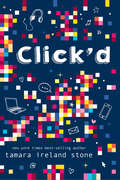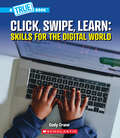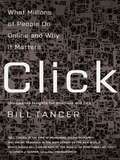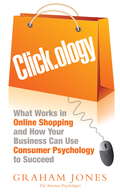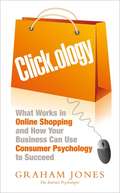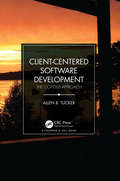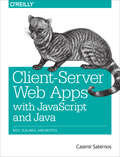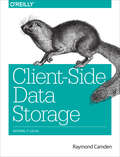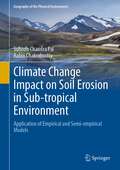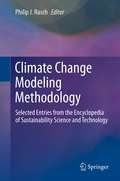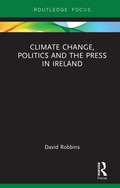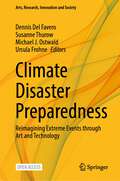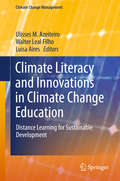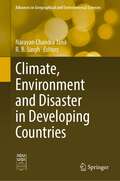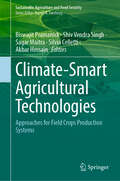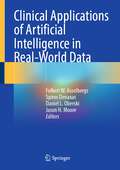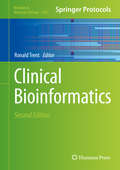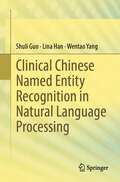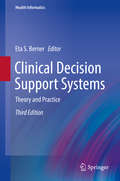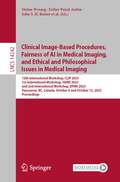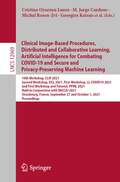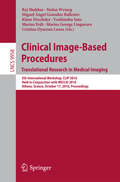- Table View
- List View
Click'd (Click'd #1)
by Tamara Ireland StoneAllie Navarro can't wait to show her best friends the app she built at CodeGirls summer camp. Click'd pairs users based on common interests and sends them on a fun (and occasionally rule-breaking) scavenger hunt to find each other. And it's a hit. By the second day of school, everyone is talking about Click'd.Watching her app go viral is amazing. Leaderboards are filling up! Everyone's making new friends. And with all the data Allie is collecting, she has an even better shot at beating her archenemy, Nathan, at the upcoming youth coding competition. But when Allie discovers a glitch that threatens to expose everyone's secrets, she has to figure out how to make things right, even if that means sharing the computer lab with Nathan. Can Allie fix her app, stop it from doing any more damage, and win back the friends it hurt-all before she steps on stage to present Click'd to the judges?New York Times best-selling author Tamara Ireland Stone combines friendship, coding, and lots of popcorn in her fun and empowering middle-grade debut.
Click, Swipe, Learn: Skills for the Digital World (A True Book)
by Cody CraneHow can kids use the internet smartly? Discover it with this step-by-step guide for young readers.Kids spend about five hours a day connecting with digital content-consuming it and/or creating it. Some of that content might include misinformation and altered images. It may even promote biases or dangerous ideas. Creating content includes pitfalls too-from copyright infringement to posting information that could be harmful or damaging. That's why digital literacy is so important. Click, Swipe, Learn: Skills for the Digital World uses engaging, interactive text-including critical-thinking questions-to show kids exactly what they need to watch out for as they navigate the digital world.ABOUT THIS SERIES:The world of media and technology is changing fast-and young students are right there in the thick of it. As children try to make sense of new technologies, they face a variety of critical issues, including how to access reliable sources of information, how to protect themselves online, and how to use technology in mindful and respectful ways. That's where the books in the Our Digital Future series can help. Each title has been developed to help young readers think critically and navigate new technologies with confidence and care.
Click: What Millions of People Are Doing Online and Why It Matters
by Bill TancerWhat time of year do teenage girls search for prom dresses online? How does the quick adoption of technology affect business success (and how is that related to corn farmers in Iowa)? How do time and money affect the gender of visitors to online dating sites? And how is the Internet itself affecting the way we experience the world? In Click, Bill Tancer takes us behind the scenes into the massive database of online intelligence to reveal the naked truth about how we use the Web, navigate to sites, and search for information--and what all of that says about who we are. As online directories replace the yellow pages, search engines replace traditional research, and news sites replace newsprint, we are in an age in which we've come to rely tremendously on the Internet--leaving behind a trail of information about ourselves as a culture and the direction in which we are headed. With surprising and practical insight, Tancer demonstrates how the Internet is changing the way we absorb information and how understanding that change can be used to our advantage in business and in life. Click analyzes the new generation of consumerism in a way no other book has before, showing how we use the Internet, and how those trends provide a wealth of market research nearly as vast as the Internet itself. Understanding how we change is integral to our success. After all, we are what we click.
Clickology
by Graham JonesOnline shopping continues to grow at an astounding rate: in 2012, more than $1 trillion was spent in online retailers alone. The nature of shopping is drastically changing, but with so little information on how best to interact with online customers, how are businesses to succeed?With Click.ology, internet psychologist Graham Jones has filled that gap. Through years of research into Internet psychology and online consumer habits, Jones has written the first how-to of its kind for online businesses. With his C.L.I.C.K. system, businesses will learn the crucial ways in which online shopping differs from traditional brick-and-mortar salesmanship and how to tweak their websites to avoid the dreaded "abandoned shopping cart." Jones tackles tricky psychological subjects such as priming customers for a certain price point and the social aspect of online shopping in a way that makes his strategies easy to implement. In addition to these essential tips, Jones investigates the fast-paced future of ecommerce and what businesses can do to stay ahead of the game. In an online world where customers make their choices in a matter of seconds, Click.ology distills the essentials every company in the online economy needs to know in order to turn clicks into dollars.Graham Jones is an Internet psychologist who helps businesses understand the online behavior of their customers and website visitors. He was one of the first psychologists in the world to start investigating the way human behavior has adapted to the online world. He lives in the United Kingdom.
Clickology: What Works in Online Shopping and How Your Business can use Consumer Psychology to Succeed
by Graham JonesThe world of shopping is at a crossroads. While online sales are growing at runaway speed, many businesses are finding themselves left behind, discovering that what has worked so long in offline does not work online, and what works online does not necessarily translate offline: it simply doesn't click. Packed with tips, guidance and real-world case studies from online niche stores Bellabox and Facetache to the universal appeal of Groupon, and from offline discount stores Dollar Tree and Poundland to the luxury Selfridges in this informative book internet psychologist Graham Jones reveals: *Why most online shopping carts are abandoned before a purchase is ever made and how to stop this happening in your store *Why having a centrally positioned search box aids navigation and increases sales *Why offering free shipping online pays off * Why it makes sense to be sociable He also reveals the why of consumer behaviour online, how it differs from offline behaviour, and how you can use this understanding to create a store that connects with and engages your customers on both a practical and a psychological level a store that demonstrates true clickology. Using an accessible five-step CLICK system for turning clicks into dollars, the book shows how to learn from the experience of both on- and offline, and apply lessons to both. Whether you re running a small business website or that of a big corporation, whether you're operating purely online or offline too, Clickology shows you how to thrive.
Clickology: What Works in Online Shopping and How Your Business can use Consumer Psychology to Succeed
by Graham JonesThe world of shopping is at a crossroads. While online sales are growing at runaway speed, many businesses are finding themselves left behind, discovering that what has worked so long in offline does not work online, and what works online does not necessarily translate offline: it simply doesn't click. Packed with tips, guidance and real-world case studies from online niche stores Bellabox and Facetache to the universal appeal of Groupon, and from offline discount stores Dollar Tree and Poundland to the luxury Selfridges in this informative book internet psychologist Graham Jones reveals: *Why most online shopping carts are abandoned before a purchase is ever made and how to stop this happening in your store *Why having a centrally positioned search box aids navigation and increases sales *Why offering free shipping online pays off * Why it makes sense to be sociable He also reveals the why of consumer behaviour online, how it differs from offline behaviour, and how you can use this understanding to create a store that connects with and engages your customers on both a practical and a psychological level a store that demonstrates true clickology. Using an accessible five-step CLICK system for turning clicks into dollars, the book shows how to learn from the experience of both on- and offline, and apply lessons to both. Whether you re running a small business website or that of a big corporation, whether you're operating purely online or offline too, Clickology shows you how to thrive.
Client-Centered Software Development: The CO-FOSS Approach
by Allen B. TuckerClient-Centered Software Development: The CO-FOSS Approach introduces a method to creating a customized software product for a single client, either from scratch or by reusing open source components. The clients are typically non-profit humanitarian, educational, or public service organizations. This approach has been used in undergraduate courses where students learn the principles of software development while implementing a real-world software product. This book provides instructors, students, clients, and professional software developers with detailed guidance for developing a new CO-FOSS product from conceptualization to completion. Features Provides instructors, students, clients, and professional software developers with a roadmap for the development of a new CO-FOSS product from conceptualization to completion Motivates students with real-world projects and community service experiences Teaches all elements of the software process, including requirements gathering, design, collaboration, coding, testing, client communication, refactoring, and writing developer and user documentation Uses source code that can be reused and refitted to suit the needs of future projects, since each CO-FOSS product is free and open source software Provides links to a rich variety of resources for instructors and students to freely use in their own courses that develop new CO-FOSS products for other non-profits.
Client-Server Web Apps with JavaScript and Java: Rich, Scalable, and RESTful
by Casimir SaternosAs a Java programmer, how can you tackle the disruptive client-server approach to web development? With this comprehensive guide, you’ll learn how today’s client-side technologies and web APIs work with various Java tools. Author Casimir Saternos provides the big picture of client-server development, and then takes you through many practical client-server architectures. You’ll work with hands-on projects in several chapters to get a feel for the topics discussed.User habits, technologies, and development methods have drastically altered web app design in recent years. But the Web itself hasn’t changed. This book shows you how to build apps that conform to the web’s underlying architecture.Learn the advantages of using separate client and server tiers, including code organization and speedy prototypingExplore the major tools, frameworks, and starter projects used in JavaScript developmentDive into web API design and REST style of software architectureUnderstand Java’s alternatives to traditional packaging methods and application server deploymentBuild projects with lightweight servers, using jQuery with Jython, and Sinatra with AngularCreate client-server web apps with traditional Java web application servers and libraries
Client-Side Data Storage: Keeping It Local
by Raymond CamdenOne of the most useful features of today’s modern browsers is the ability to store data right on the user’s computer or mobile device. Even as more people move toward the cloud, client-side storage can still save web developers a lot of time and money, if you do it right. This hands-on guide demonstrates several storage APIs in action. You’ll learn how and when to use them, their plusses and minuses, and steps for implementing one or more of them in your application.Ideal for experienced web developers familiar with JavaScript, this book also introduces several open source libraries that make storage APIs easier to work with.Learn how different browsers support each client-side storage APIWork with web (aka local) storage for simple things like lists or preferencesUse IndexedDB to store nearly anything you want on the user’s browserLearn how support web apps that still use the discontinued Web SQL Database APIExplore Lockr, Dexie, and localForage, three libraries that simplify the use of storage APIsBuild a simple working application that makes use of several storage techniques
Climate Change Communication and the Internet
by Nelya Koteyko, Brigitte Nerlich and Iina HellstenThe volume provides a timely, state of the art collection of studies examining climate change communication in the era of digital media. The chapters focus on a broad range of topics covering various aspects of both practice and research in climate change communication, ranging from the use of online platforms, to blogs, and social networking sites. Climate change communication has increasingly moved into Internet-based forums, and this volume provides a comprehensive overview of research into Internet and climate change communication. The studies share valuable methodological insights in this relatively new field of research and shed light on the opportunities and challenges underlying the collection and analysis of online climate change-related data. This book was previously published as a special issue of Environmental Communication.
Climate Change Impact on Soil Erosion in Sub-tropical Environment: Application of Empirical and Semi-empirical Models (Geography of the Physical Environment)
by Subodh Chandra Pal Rabin ChakraborttyThis work focuses on the potential impact of climate change on soil erosion in a monsoon-dominated sub-tropical region. Water-induced soil erosion due to extreme rainfall during the monsoon period is a major problem worldwide, from different environmental and socio-economic perspectives. This study region covered (South Bengal) is one of the fertile agricultural belts that produces a good amount of produce and contributes to the country's GDP. However, the rate of agricultural output has decreased rapidly in recent times due to a decline in soil fertility. The monsoon-dominated sub-tropical region has unique characteristics in terms of seasonal temperature fluctuations and the availability of rainfall events. The sub-tropical region is densely populated, with the majority of the population relying on rain-fed agricultural production systems. The declining rate of agricultural production has also established that soil fertility is declining and soil erosion is increasing. Numerous studies show that soil erosion is the major cause of the region's rapidly increasing trend of land degradation. A homeostatic mechanism cannot replace soil erosion, and a gap arises between soil erosion and regolith formation. Extreme changes in land use and land cover, population growth and the lacking support for traditional agricultural practices and management practices can accelerate the rate of soil erosion and its associated reservoir sedimentation in most countries of the tropical and sub-tropical environment. Quantitative information with maximum possible accuracy through validation regarding soil loss can be an essential part of the appropriate and sustainable soil and water conservation planning. The precise aspects of modern day management strategies are soil erosion susceptibility mapping using empirical and semi-empirical models in a GIS platform or the use of probability statistics. The main objective of this work is to propose the most suitable development strategies considering the amount of soil erosion for the present and future periods. Extensive field research has been done to identify the support practice factor that the local stakeholders adopt in this region.
Climate Change Modeling Methodology: Selected Entries from the Encyclopedia of Sustainability Science and Technology
by Philip J. RaschThe Earth's average temperature has risen by 1.4°F over the past century, and computer models project that it will rise much more over the next hundred years, with significant impacts on weather, climate, and human society. Many climate scientists attribute these increases to the build up of greenhouse gases produced by the burning of fossil fuels and to the anthropogenic production of short-lived climate pollutants. Climate Change Modeling Methodologies: Selected Entries from the Encyclopaedia of Sustainability Science and Technology provides readers with an introduction to the tools and analysis techniques used by climate change scientists to interpret the role of these forcing agents on climate. Readers will also gain a deeper understanding of the strengths and weaknesses of these models and how to test and assess them. The contributions include a glossary of key terms and a concise definition of the subject for each topic, as well as recommendations for sources of more detailed information.
Climate Change, Politics and the Press in Ireland (Routledge Focus on Environment and Sustainability)
by David RobbinsMedia coverage of climate change has attracted much scholarly attention because the extent of such coverage has an agenda-setting effect and because the ways in which the coverage is framed can influence public perception of and engagement with the issue. However, certain gaps in our understanding of the processes whereby such coverage is produced remain. The competition among strategic actors to influence media framing strategies is poorly understood, and the perspectives of journalists and editors are largely absent from literature. With a view to advancing our understanding of the "frame competition" around climate change and to presenting the perspectives of journalists regarding climate change as a journalistic topic, this book presents an in-depth case history of media coverage of climate change in Ireland. First, the extent of media attention for climate change is established, and the way in which such coverage is framed is also examined. Through a series of interviews, including rare and privileged access to government ministers, their media advisors, and journalists and editors, the book uncovers the contest to establish a dominant framing. The main objective of this book is to advance our understanding of the contest to establish the dominant framing of climate change in the media discourse. Although focussed on Ireland, its conclusions are of value to those seeking to better understand the dynamics of media coverage of climate change in other contexts. This book will be of great interest to students and scholars of climate change, environmental policy, media and communication studies, and Irish politics.
Climate Disaster Preparedness: Reimagining Extreme Events through Art and Technology (Arts, Research, Innovation and Society)
by Michael J. Ostwald Ursula Frohne Dennis Del Favero Susanne ThurowAs a result of global warming, extreme events, such as firestorms and flash floods, pose increasingly unpredictable and uncertain existential threats, taking lives, destroying communities, and wreaking havoc on habitats. Current aesthetic, technological and scientific frameworks struggle to imagine, visualise and rehearse human interactions with these events, hampering the development of proactive foresight, readiness and response.This open access book demonstrates how the latest advances in creative arts, intelligent systems and climate science can be integrated and leveraged to transform the visualisation of extreme event scenarios. It reframes current practice from passive perception of pre-scripted illustrations to active immersion in evolving life-like interactive scenarios that are geo-located. Drawing on the multidisciplinary expertise of leaders in the creative arts, climate sciences, environmental engineering, and intelligent systems, this book examines the waysin which climate disaster preparedness can be reformulated through practices that address dynamic and unforeseen interactions between climate and human life worlds. Grouped into four sections (picturing, narrating, rehearsing, and communicating), this book maps this approach by exploring the emerging strengths and current limitations of each discipline in addressing the challenge of envisioning the unpredictable interaction of extreme events with human populations and environments. This book provides a timely intervention into the global discourse on how art, culture and technology can address climate disaster resilience. It appeals to readers from multiple fields, offering academic, industry and community audiences novel insights into a profound gap in the current knowledge, policy and action landscape.
Climate Literacy and Innovations in Climate Change Education: Distance Learning for Sustainable Development (Climate Change Management)
by Walter Leal Filho Ulisses M. Azeiteiro Luísa AiresThis book addresses the links between climate change and the threats it poses to sustainable development, from a distance education perspective. Discussing current trends and challenges in sustainable development education, climate literacy and innovations in climate change education, it contributes to the global debate on the implementation of education for sustainability. It also assesses the role that e-learning can play in this process, addressing pedagogical concepts as well as the wide range of technological options now available.
Climate, Environment and Disaster in Developing Countries (Advances in Geographical and Environmental Sciences)
by R. B. Singh Narayan Chandra JanaThe world is currently experiencing changes in climate and environment that often lead to natural disasters. Nearly three million people worldwide may have been killed in the past 20 years by natural disasters. In total, 90% of the natural disasters and 95% of all disaster-related deaths occur in the developing countries. Recently such problems have accelerated due to LULC change, biodiversity degradation, increased tourism, urbanization and climate change. This book, consisting of 27 chapters, explores the topics of climate, environment and natural disasters in developing countries. It is essential to discuss these diverse issues in the field of geography as it encompasses interdisciplinary topics. The range of issues on national, regional and local dimensions is not only confined to geography but also concerned to other disciplines as well. Therefore, this book is a valuable source for scientists and researchers in allied fields such as climatology, disaster management, environmental science, hydrology, agriculture, and land use studies, among other areas. Furthermore, this book can be of immense help to the planners and decision-makers engaged in dealing with the problems of climate, environmental change and natural disasters in developing countries.
Climate-Smart Agricultural Technologies: Approaches for Field Crops Production Systems (Sustainability Sciences in Asia and Africa)
by Akbar Hossain Biswajit Pramanick Shiv Vendra Singh Sagar Maitra Silvia CellettiThis book addresses the technologies that can be employed to tackle the challenges of global food security. Several recent studies have reported the significant impact of changing climate on the agricultural production, thus posing a challenge in achieving global food security. Thus, to mitigate these challenges there is an urgent need to develop approaches that may be helpful for the sustainability of food production. These approaches are based on three objectives: (i) sustainably increasing agricultural productivity to support equitable increases in farm incomes, food security, and development; (ii) adapting and building the resilience of food systems to climate change; and (iii), where possible, reducing GHGs emissions from agriculture. This book provides updated information for these climate-smart agricultural technologies that hold high potential to increase productivity, improve resilience, and provide efficient resource utilization. This book is a valuable resource for undergraduates, postgraduates, researchers, professors and policymakers in the field of agriculture, botany and agriculture extension functionaries.
Clinical Applications of Artificial Intelligence in Real-World Data
by Jason H. Moore Folkert W. Asselbergs Spiros Denaxas Daniel L. OberskiThis book is a thorough and comprehensive guide to the use of modern data science within health care. Critical to this is the use of big data and its analytical potential to obtain clinical insight into issues that would otherwise have been missed and is central to the application of artificial intelligence. It therefore has numerous uses from diagnosis to treatment. Clinical Applications of Artificial Intelligence in Real-World Data is a critical resource for anyone interested in the use and application of data science within medicine, whether that be researchers in medical data science or clinicians looking for insight into the use of these techniques.
Clinical Bioinformatics (Methods in Molecular Biology #1168)
by Ronald TrentIn Clinical Bioinformatics, Second Edition, leading experts in the field provide a series of articles focusing on software applications used to translate information into outcomes of clinical relevance. Recent developments in omics, such as increasingly sophisticated analytic platforms allowing changes in diagnostic strategies from the traditional focus on single or small number of analytes to what might be possible when large numbers or all analytes are measured, are now impacting patient care. Covering such topics as gene discovery, gene function (microarrays), DNA sequencing, online approaches and resources, and informatics in clinical practice, this volume concisely yet thoroughly explores this cutting-edge subject Written in the successful Methods in Molecular Biology series format, chapters include introductions to their respective topics, lists of the necessary materials and reagents, step-by-step, readily reproducible protocols, and notes on troubleshooting and avoiding known pitfalls. Authoritative and easily accessible, Clinical Bioinformatics, Second Edition serves as an ideal guide for scientists and health professionals working in genetics and genomics.
Clinical Chinese Named Entity Recognition in Natural Language Processing
by Shuli Guo Lina Han Wentao YangThis book introduces how to enhance the context capture ability of the model, improve the position information perception ability of the pretrained models, and identify and denoise the unlabeled entities. The Chinese medical named entity recognition is an important branch of the intelligent medicine, which is beneficial to mine the information hidden in medical texts and provide the medical entity information for clinical medical decision-making and medical classification. Researchers, engineers and post-graduate students in the fields of medicine management and software engineering.
Clinical Decision Support Systems: Theory and Practice (Health Informatics)
by Eta S. BernerBuilding on the success of the previous editions, this fully updated book once again brings together worldwide experts to illustrate the underlying science and day-to-day use of decision support systems in clinical and educational settings. Topics discussed include: -Mathematical Foundations of Decision Support Systems -Design and Implementation Issues -Ethical and Legal Issues in Decision Support -Clinical Trials of Information Interventions -Hospital-Based Decision Support -Real World Case Studies
Clinical Image-Based Procedures, Fairness of AI in Medical Imaging, and Ethical and Philosophical Issues in Medical Imaging: 12th International Workshop, CLIP 2023 1st International Workshop, FAIMI 2023 and 2nd International Workshop, EPIMI 2023 Vancouver, BC, Canada, October 8 and October 12, 2023 Proceedings (Lecture Notes in Computer Science #14242)
by Daniel Moyer Cristina Oyarzun Laura Stefan Wesarg Klaus Drechsler Marius Erdt Aasa Feragen Ben Glocker Veronika Cheplygina Enzo Ferrante Islem Rekik Yufei Chen Esther Puyol Antón John S. H. Baxter Roy Eagleson Andrew P. King Moti Freiman Melani Ganz-Benjaminsen Eikel PetersenThis book constitutes the refereed proceedings of the 12th International Workshop on Clinical Image-Based Procedures, CLIP 2023, the First MICCAI Workshop on Fairness of AI in Medical Imaging, FAIMI 2023, held in conjunction with MICCAI 2023, in October 2023, and the Second MICCAI Workshop on the Ethical and Philosophical Issues in Medical Imaging, EPIMI 2023.CLIP 2023 accepted 5 full papers and 3 short papers form 8 submissions received. It focuses on holistic patient models for personalized healthcare with the goal to bring basic research methods closer to the clinical practice.For FAIMI 2023, 19 full papers have been accepted from 20 submissions. They focus on creating awareness about potential fairness issues that can emerge in the context of machine learning. And for EPIMI 2023, 2 papers have been accepted from 5 submissions. They investigate questions that underlie medical imaging research at the most fundamental level.
Clinical Image-Based Procedures, Distributed and Collaborative Learning, Artificial Intelligence for Combating COVID-19 and Secure and Privacy-Preserving Machine Learning: 10th Workshop, CLIP 2021, Second Workshop, DCL 2021, First Workshop, LL-COVID19 2021, and First Workshop and Tutorial, PPML 2021, Held in Conjunction with MICCAI 2021, Strasbourg, France, September 27 and October 1, 2021, Proceedings (Lecture Notes in Computer Science #12969)
by Cristina Oyarzun Laura Raj Shekhar Stefan Wesarg Klaus Drechsler Marius Erdt Marius George Linguraru Daniel Rueckert M. Jorge Cardoso Shadi Albarqouni Spyridon Bakas Bennett Landman Nicola Rieke Holger Roth Daguang Xu Michal Rosen-Zvi Georgios Kaissis Yufei Chen Xiaoxiao Li Maria Gabrani Ender Konukoglu Michal Guindy Alexander Ziller Dmitrii Usynin Jonathan Passerat-PalmbachThis book constitutes the refereed proceedings of the 10th International Workshop on Clinical Image-Based Procedures, CLIP 2021, Second MICCAI Workshop on Distributed and Collaborative Learning, DCL 2021, First MICCAI Workshop, LL-COVID19, First Secure and Privacy-Preserving Machine Learning for Medical Imaging Workshop and Tutorial, PPML 2021, held in conjunction with MICCAI 2021, in October 2021. The workshops were planned to take place in Strasbourg, France, but were held virtually due to the COVID-19 pandemic.CLIP 2021 accepted 9 papers from the 13 submissions received. It focuses on holistic patient models for personalized healthcare with the goal to bring basic research methods closer to the clinical practice. For DCL 2021, 4 papers from 7 submissions were accepted for publication. They deal with machine learning applied to problems where data cannot be stored in centralized databases and information privacy is a priority. LL-COVID19 2021 accepted 2 papers out of 3 submissions dealing with the use of AI models in clinical practice. And for PPML 2021, 2 papers were accepted from a total of 6 submissions, exploring the use of privacy techniques in the medical imaging community.
Clinical Image-Based Procedures. Translational Research in Medical Imaging: 5th International Workshop, CLIP 2016, Held in Conjunction with MICCAI 2016, Athens, Greece, October 17, 2016, Proceedings (Lecture Notes in Computer Science #9958)
by Cristina Oyarzun Laura Raj Shekhar Stefan Wesarg Miguel Ángel González Ballester Klaus Drechsler Yoshinobu Sato Marius Erdt Marius George LinguraruThis book constitutes the revised selected papers from the 5th International Workshop on Clinical Image-Based Procedures, CLIP 2016, held in conjunction with MICCAI 2016 in Athens, Greece, in October 2016. The 10 papers presented in this volume were carefully reviewed and selected from 16 submissions. Specific topics include various image segmentation and registration techniques, applied to various parts of the body. They range from interventional planning to navigation of devices and navigation to the anatomy of interest. Clinical applications cover the skull, the cochlea, cranial nerves, the aortic valve, wrists, and the abdomen, among others.
Clinical Image-Based Procedures. Translational Research in Medical Imaging: Second International Workshop, CLIP 2013, Held in Conjunction with MICCAI 2013, Nagoya, Japan, September 22, 2013, Revised Selected Papers (Lecture Notes in Computer Science #8361)
by Marius Erdt, Marius George Linguraru, Cristina Oyarzun Laura, Raj Shekhar, Stefan Wesarg, Miguel Angel González Ballester and Klaus DrechslerThis book constitutes revised selected papers from the International Workshop on Clinical Image-Based Procedures, CLIP 2013, held in conjunction with MICCAI 2012 in Nagoya, Japan, in September 2013. The 19 papers presented in this volume were carefully reviewed and selected from 26 submissions. The workshop was a productive and exciting forum for the discussion and dissemination of clinically tested, state-of-the-art methods for image-based planning, monitoring and evaluation of medical procedures.
